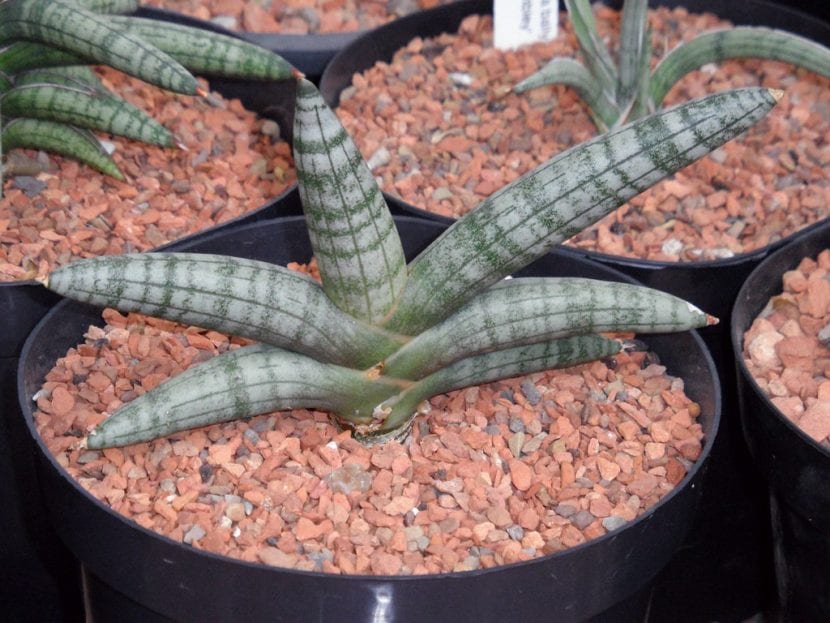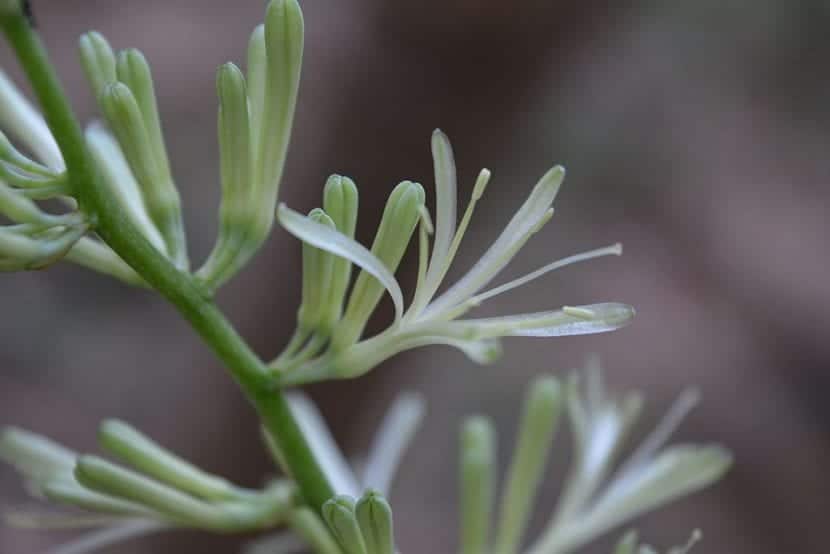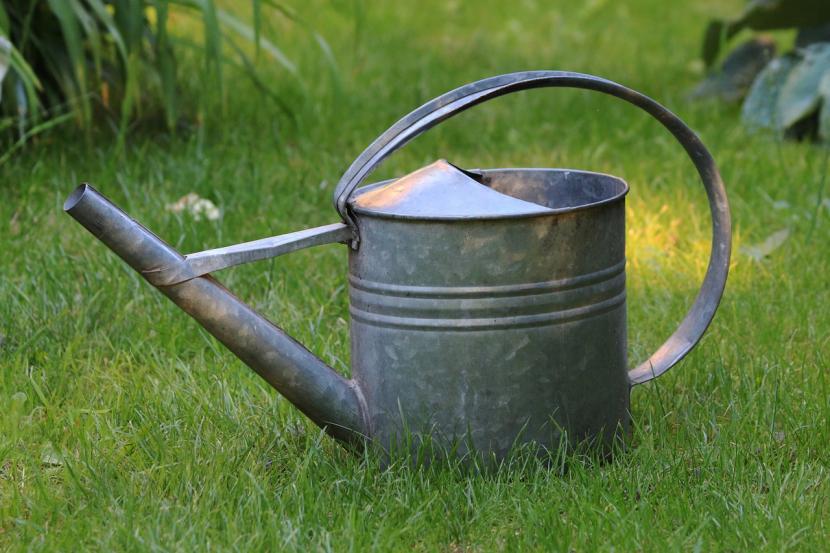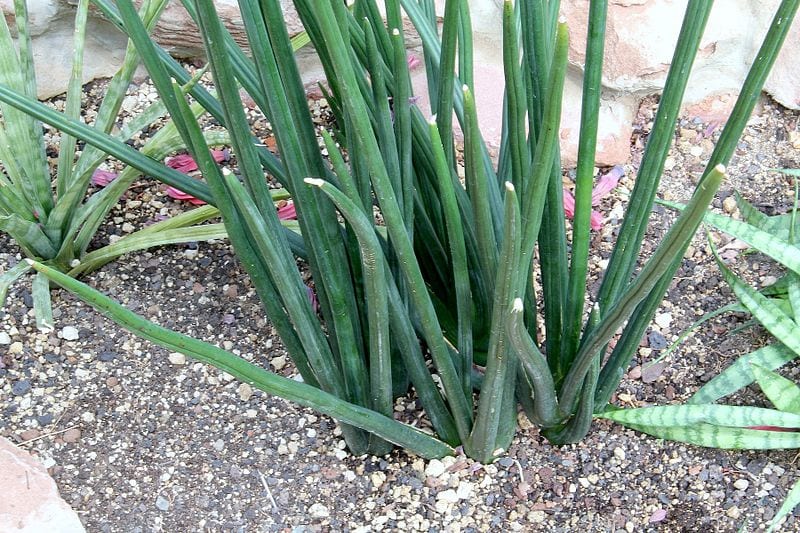
There are many plants that fit perfectly in a garden or collection of cacti, succulents and / or caudiciforms, and without a doubt one of the most popular is the Sansevieria. Placed in those areas where the sun's rays do not reach directly, they are wonderful.
They do not require much care, and they also have a quality that has been recognized by NASA itself that cannot be ignored 😉.
Origin and characteristics of Sansevieria
Our protagonist is a genus of herbaceous, perennial and rhizomatous plants composed of about 130 species native to Africa and Asia. They are known as the serpent's plant, lizard's tail, mother-in-law's tongue, or Saint George's sword, and they are characterized by having generally long, wide and flat leaves, but they can also be concave or cylindrical, greenish, green and yellow, or greyish with or without spots.
The flowers are grouped in racemes, panicles, spikes or fascicles, and are white. The fruit is an inedible berry that ripens in summer-autumn.
Main species
The best known are:
Sansevieria trifasciata

Image - Wikimedia / Mokkie // Sansevieria trifasciata 'Laurentii'
It is a plant native to western tropical Africa to Nigeria and east to the Democratic Republic of the Congo. Its leaves are very long, being able to reach 140 centimeters long up to 10 centimeters wide, rigid, and dark green with lighter green transverse lines.
The flowers are grouped in clusters up to 80 centimeters long, and are greenish-white. The fruit is an orange berry.
Sansevieria cylindrica

Image - Flickr / Marlon Machado // Sansevieria cylindrica var. patula 'Boncel'
It is a plant native to tropical Africa, especially Angola, which has no more than five cylindrical or slightly flattened leaves up to 2 meters long by 3 centimeters in diameter, green with bands of a darker green.
The white flowers emerge from a leafless flower stalk called an escape that is up to 1 meter long. The fruit is a small berry about 0,8 centimeters in diameter.
What are their cares?
If you want to have a copy, we recommend that you provide it with the following care:
Location
It will depend on where you want to have it 🙂:
- Interior: in a bright room, but without direct light.
- Body exterior:: in semi-shade, for example, under the shade of a tree.
Earth
Again, it depends:
- Flower pot: It is very adaptable, but will grow best in a mix of the universal growing medium style with 50% perlite. You can get the first here and the second here. Other options are the akadama (for sale here) or the pumice (for sale here).
- Garden: grows in poor soils, with very good drainage. If yours is not like this, feel free to make a planting hole of about 50 x 50 centimeters, and fill it with the mixture of substrates mentioned above.
Irrigation

Image - Wikimedia / Vinayaraj // Flowers of Sansevieria trifasciata
This is one of the things that Sansevieria have in common with cacti, succulents, and ultimately with the succulents that we all know: require rather low risks. In fact, this is one of the reasons why they would not clash in a garden of cacti, or succulents, or even among a group of Pachypodium lamerei for example.
They are very sensitive to root rot caused by waterlogging, so you only need to water when the soil is completely dry. More or less, the ideal is to proceed to water it once a week in summer, and every 10-20 days the rest of the year.

The leaves should never be wet, and if you have a plate underneath, you have to remove the excess water 20 minutes after watering.
Subscriber
From early spring to late summer. You can use the liquid succulent fertilizer that you already have at home, or that you can buy from here. Follow the instructions specified on the package to avoid the consequences of overdose (damaged roots, yellowish or dry leaves, growth arrest and / or plant death).
Planting and / or transplanting time
In spring, when the risk of frost has passed.
Plagues and diseases

Image - Wikimedia / Peter A. Mansfeld // Sansevieria erythraeae
It's very tough. However, it is necessary to control the molluscs (especially snails) during the rainy season. Also they mushrooms when overwatered.
Multiplication
The Sansevieria multiplies by seeds and by separation of suckers in spring-summer. Let's see how to proceed in each case:
Seeds
To multiply it by seeds, you have to fill a pot with holes with universal substrate mixed with 50% perlite, moisten them well and then put them on the surface, covering them with a little substrate.
Placing the pot near a heat source, and keeping the soil moistened, will germinate in about two to three weeks.
Young
They can be separated carefully, with the help of a small hoe if it is in the ground, or by removing the plant from the pot and cutting it with a previously disinfected knife, and then planting it in another area of the garden or in another container.
Rusticity
Resists cold, but frost hurts. From experience, I tell you that if it drops to -2ºC in a timely and brief way, nothing will happen to it, but it does suffer damage from hail.
What uses are they given?

Image - Wikimedia / Peter A. Mansfeld // Sansevieria grandis
Sansevieria are plants that they are used only as ornamentals, but other than that, also they are excellent air purifiers. Specifically, NASA in a study 1989 revealed that Sansevieria trifasciata removes benzene, xylene and toluene, thus cleaning the air we breathe.
What do you think of these plants? You have someone?